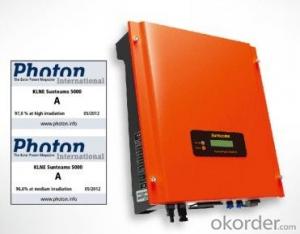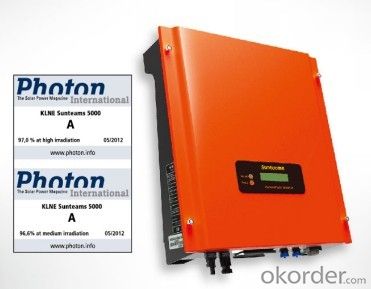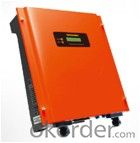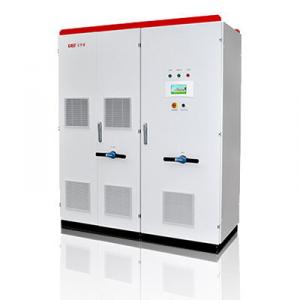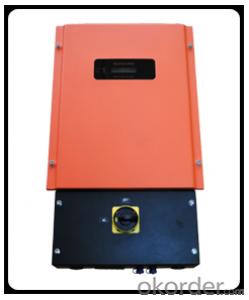Sunteams 3000 12V Solar Inverter Battery Charger with WiFi US Standard
- Loading Port:
- Shanghai
- Payment Terms:
- TT OR LC
- Min Order Qty:
- -
- Supply Capability:
- 10000 set/month
OKorder Service Pledge
Quality Product, Order Online Tracking, Timely Delivery
OKorder Financial Service
Credit Rating, Credit Services, Credit Purchasing
You Might Also Like
Sunteams 1500,2000,2500,3000,3600,4000,4600,5000
Sunteams US 1500,2000,2500,3000,3600,4000,4600,5000
1MPPT, single phase
IP 65
50Hz & 60 Hz
with Plug in wifi/ wifi box
with wire box/ without wire box
UL certified
■ For countries with UL certification (UL 1741 / IEEE 1547)
■ For countries with UL certification (UL 1741 / IEEE 1547)
Efficient
■ The CEC efficiency of the inverter can reach 95.0 %-97.5 %
■ Transformerless desi
■ The CEC efficiency of the inverter can reach 95.0 %-97.5 %
■ Transformerless desi
Simple
■ ‘Plug and play’connection for easy installation and maintenance
■ Designed for hanging with simple and easy installation
■ Fanless cooling concept
■ ‘Plug and play’connection for easy installation and maintenance
■ Designed for hanging with simple and easy installation
■ Fanless cooling concept
Communicative
■ RS232/RS485 interfaces as standard
■ Optional Bluetooth technology
■ RS232/RS485 interfaces as standard
■ Optional Bluetooth technology
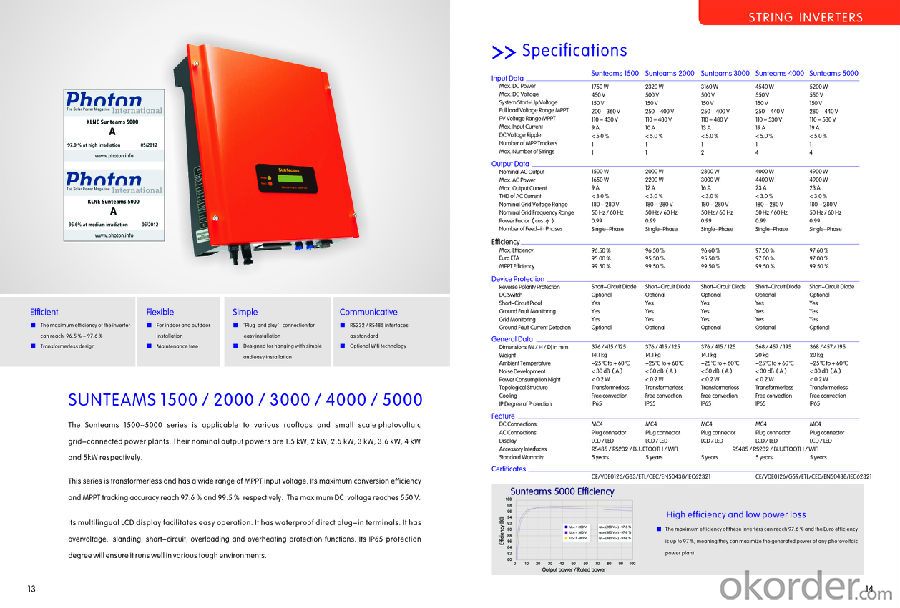
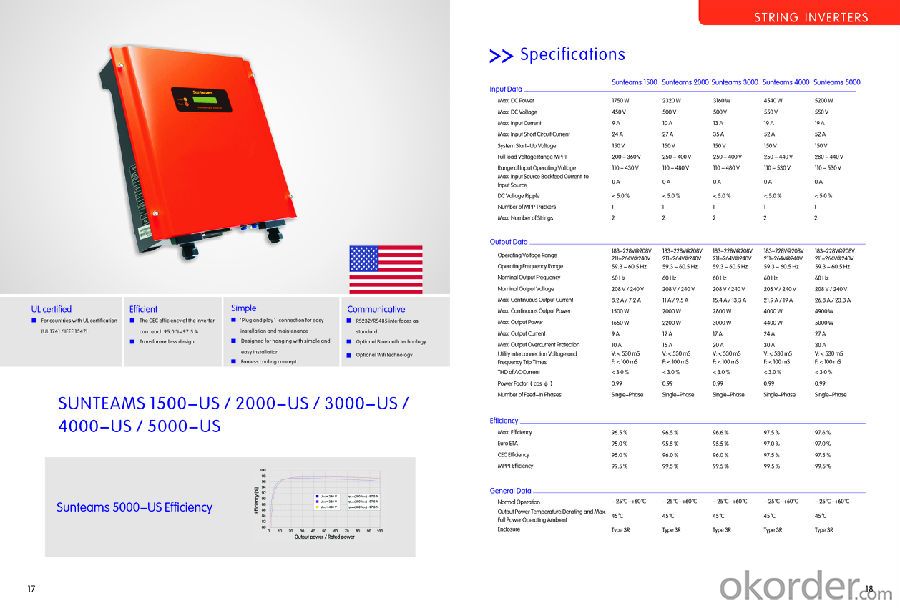

- Q: Can a solar inverter be used with different AC voltage systems?
- Yes, a solar inverter can be used with different AC voltage systems as long as it is compatible with the specific voltage range and frequency of the AC system.
- Q: Can a solar inverter be used with different types of grounding configurations?
- Yes, a solar inverter can be used with different types of grounding configurations. Solar inverters are typically designed to be compatible with various grounding systems, including grounded, ungrounded, or floating configurations. However, it is important to consult the manufacturer's specifications and guidelines to ensure proper installation and operation in accordance with the specific grounding requirements.
- Q: Can a solar inverter be used with different tracking algorithms?
- Yes, a solar inverter can be used with different tracking algorithms. Solar inverters are designed to convert the direct current (DC) power generated by solar panels into alternating current (AC) power suitable for use in homes and businesses. The tracking algorithm is responsible for optimizing the solar panel's output by adjusting the angle and orientation of the panels to maximize sunlight exposure. Different tracking algorithms can be utilized depending on factors such as location, weather conditions, and system requirements. Solar inverters are typically equipped with the capability to support various tracking algorithms, allowing for flexibility and customization to meet specific needs.
- Q: What is the role of a frequency regulation feature in a solar inverter?
- The role of a frequency regulation feature in a solar inverter is to maintain a stable and consistent frequency of the electrical output, ensuring compatibility with the grid or connected appliances. This feature helps to mitigate fluctuations in frequency caused by varying solar irradiance or load fluctuations, thereby improving the overall efficiency and reliability of the solar power system.
- Q: Can a solar inverter be used with a solar-powered agricultural irrigation system?
- Yes, a solar inverter can be used with a solar-powered agricultural irrigation system. The solar inverter is responsible for converting the direct current (DC) produced by the solar panels into alternating current (AC) that can be used to power the irrigation system. This allows for efficient utilization of solar energy to operate the irrigation system, reducing reliance on traditional power sources and promoting sustainable agriculture practices.
- Q: How does a solar inverter handle grid islanding conditions?
- A solar inverter handles grid islanding conditions by continuously monitoring the grid voltage and frequency. In the event of a grid outage or disturbance, the solar inverter detects the change and disconnects from the grid to ensure the safety of utility workers. It then enters islanding mode, wherein it generates electricity from the solar panels and supplies it to the local loads. This prevents backfeeding and maintains a stable power supply within the isolated system.
- Q: Can a solar inverter be used in off-grid systems?
- Yes, a solar inverter can be used in off-grid systems. In fact, it is an essential component of off-grid solar systems. The solar inverter is responsible for converting the DC power generated by the solar panels into AC power that can be used to run household appliances and charge batteries. This allows off-grid systems to store excess energy for use during periods of low sunlight, providing a reliable source of electricity even when disconnected from the grid.
- Q: What is the role of fault ride-through capability in a solar inverter?
- The fault ride-through capability in a solar inverter is essential as it allows the inverter to remain connected to the grid during grid disturbances or faults. This capability ensures that the inverter can ride through and withstand voltage sags or dips in the grid, maintaining stability and continuous power generation. By providing this capability, the inverter helps to enhance grid reliability, prevent power disruptions, and contribute to the overall stability of the electrical system.
- Q: Are there any safety risks associated with solar inverters?
- Yes, there can be safety risks associated with solar inverters. While solar inverters are generally considered safe, there are a few potential hazards to be aware of. These include electrical shock, fire hazards, and the release of toxic gases. It is important to ensure proper installation, regular maintenance, and adherence to safety guidelines to mitigate these risks.
- Q: Can a solar inverter be used with a solar-powered remote sensing system?
- Yes, a solar inverter can be used with a solar-powered remote sensing system. The solar inverter is responsible for converting the direct current (DC) generated by the solar panels into alternating current (AC) that can be used to power the remote sensing system.
Send your message to us
Sunteams 3000 12V Solar Inverter Battery Charger with WiFi US Standard
- Loading Port:
- Shanghai
- Payment Terms:
- TT OR LC
- Min Order Qty:
- -
- Supply Capability:
- 10000 set/month
OKorder Service Pledge
Quality Product, Order Online Tracking, Timely Delivery
OKorder Financial Service
Credit Rating, Credit Services, Credit Purchasing
Similar products
Hot products
Hot Searches
Related keywords
